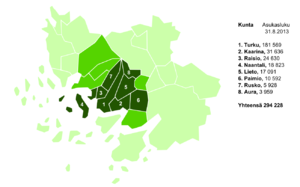Turku metropolitan area
Turun kaupunkiseutu – Åbo stadsregion | |
|---|---|
Metropolitan area | |
 Turku skyline | |
 | |
| Country | Finland |
| Region | Southwest Finland |
| Sub-region | Turku sub-region |
| Seat | Turku |
| Area | |
| • Land | 1,185.24 km2 (457.62 sq mi) |
| Population (2024-08-31) | |
| • Total | 313,785 |
| • Density | 264.7/km2 (686/sq mi) |
| GDP | |
| • Total | €20.0 billion (2021) |
| Website | turunseutu |
Turku metropolitan area or Turku region (Finnish: Turun seutu, Swedish: Åbo region) is the metropolitan area around the city of Turku in Finland. The joint municipal authority of the Turku city region (Finnish: Turun kaupunkiseutu, Swedish: Åbo stadsregion) consists of six municipalities: Turku, Kaarina, Lieto, Naantali, Raisio and Rusko.[2] The Turku metropolitan area forms a compact, urban-like regional growth centre where people commute from a relatively large area of the Southwest Finland region.
The Turku metropolitan area has a population of about 314,000, making it the third largest region in Finland after Helsinki and Tampere. The terms Turku metropolitan area, Turku region, Turku city region, Greater Turku and the other terms used are not fixed and may vary in different contexts.
Turku metropolitan area differs from the Turku sub-region (Finnish: Turun seutukunta), which also includes the municipalities of Masku, Mynämäki, Nousiainen, Paimio and Sauvo. The Turku sub-region is used for statistical purposes. It is based on cooperation between municipalities and the commuting area. The sub-region has a population of about 350,000.
Turku metropolitan area has two universities and three universities of applied sciences.[3] Finland's largest bio-industrial cluster of research and companies is located in Turku.[4] There are also ICT concentrations in the cities of Turku and Salo. The Turku metropolitan area is located on the Baltic Sea coast with its logistical activities. The region's two seaports, the Port of Turku and the Port of Naantali, and the shipbuilding industry are major employers in the area.[5] Turku Airport has logistics industries for sea, air, rail and road freight.[6]
- ^ "Gross domestic product (GDP) at current market prices by metropolitan regions". ec.europa.eu.
- ^ "Turun seutu". Retrieved 2024-03-23.
- ^ "Studying in Turku". City of Turku. Retrieved 2024-03-23.
- ^ "About us". Turku Bioscience Centre. Retrieved 2024-03-23.
- ^ "A pioneer in modern shipbuilding". Meyer Turku. Retrieved 2024-03-23.
- ^ "Excellent transport links and logistics". City of Turku. Retrieved 2024-03-23.